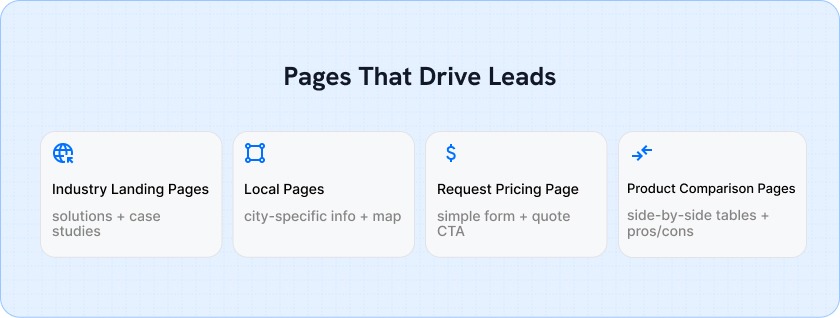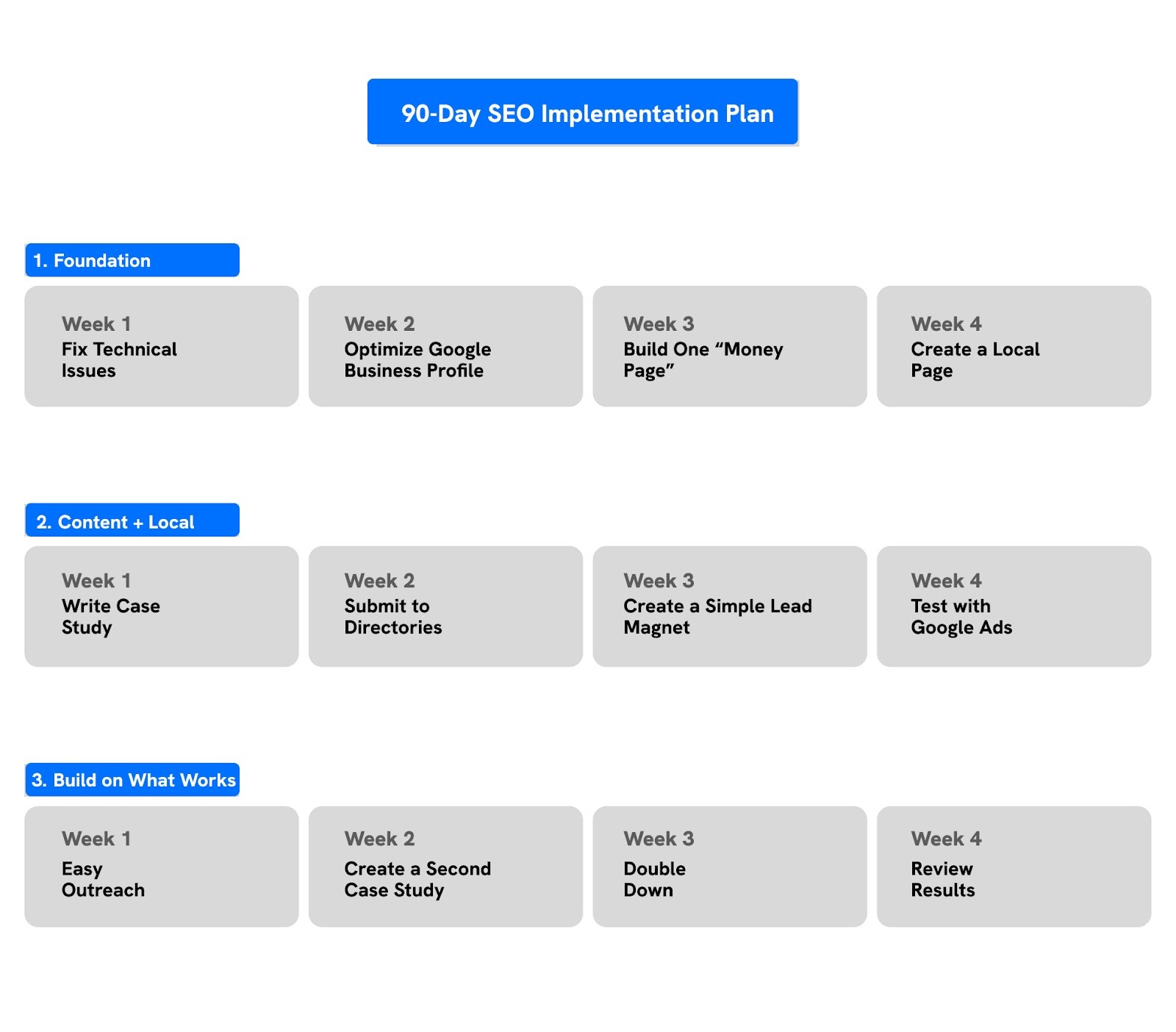Packaging companies deal with steady demand, but winning the right customers takes more than a good product line. Buyers search online first, compare suppliers fast, and expect clear answers before they reach out. If your website doesn’t show up when they look for specific packaging solutions, competitors take the lead.
That's where focused SEO for packaging companies helps. It brings your business in front of buyers who are already searching for the materials, equipment, or capabilities you offer.
With the right strategy, packaging companies can improve visibility, build trust, and pull in qualified customers in a short time.
In this blog, you’ll learn how SEO works for packaging companies and how a simple, targeted approach can help you attract more customers within 90 days.
What Is SEO?
SEO for packaging manufacturers is the process of improving your website so buyers can find you when they search for the products you offer. It focuses on making your content clear, matching the terms customers use, and helping search engines understand why your pages deserve to show up.
For packaging companies, this often includes material-specific keywords, industry applications, and capability driven topics that buyers actively look for.
What Will It Do for Your Packaging Business?
SEO helps companies show up for the exact searches buyers use when they compare suppliers. When done right, it supports your growth in several ways:
- Brings in buyers who are already looking for your materials and capabilities
- Highlights your strengths, certifications, and production capacity
- Builds trust by showing clear, accurate, helpful information
- Reduces reliance on paid ads or cold outreach
- Helps your sales team get more qualified conversations
It’s a straightforward way to improve visibility and attract customers who are ready to act.
Target These Keywords That Convert
Showing up for keywords that sound good but don’t bring buyers is one of the biggest mistakes packaging manufacturers make. Terms like “packaging industry” might generate a few hundred searches, but they attract students, job seekers, and researchers, not the customers you want.
What drives actual quotes and purchase orders are high-intent keywords: searches that signal someone is ready to buy, compare vendors, or request samples.
Here’s where you should focus:
High-Intent Keywords Competitors Often Miss
Industry-Specific “Money Keywords”
Different industries have different compliance and branding needs. These terms capture serious buyers with purchase power:
Local Modifiers That Work
Never underestimate local SEO. Adding phrases like:
This turns a general keyword into one that’s immediately actionable, often with much less competition.
Keywords to Stop Wasting Time On
- “packaging industry” (320 searches): vague, attracts researchers, not buyers.
- “types of packaging” (450 searches): informational, low buyer intent.
- “packaging definition” (1,000+ searches): purely educational, zero sales value.

Three Site Fixes That Can Improve Your SEO
Even the best keywords won’t matter if your site isn’t built to perform. Google’s algorithm rewards packaging manufacturers whose websites are fast, mobile-friendly, and structured properly, and penalizes those that aren’t. The good news? These are fixable issues that don’t require a massive budget, just some smart tweaks.
1. Site Speed Under 3 Seconds
Buyers won’t wait for your site to load, especially if they’re comparing multiple packaging vendors. Studies show that if a page takes longer than 3 seconds, over 50% of users bounce. Google factors this into rankings, too.
- How to test: Run your homepage and key product pages through GTmetrix.com. Aim for a Grade A (fully loaded under 3 seconds).
- How to fix:
- Compress large images before uploading using TinyPNG.com.
- Enable gzip compression (your developer or hosting provider can help).
- Use a content delivery network (CDN) if your customers are spread across the U.S.
2. Mobile-Friendly Product Pages

- How to test: Run your product pages through Google’s Mobile-Friendly Test.
- Best practices for manufacturers:
- Buttons and links should be at least 44px so they’re easy to tap.
- Product images should load quickly and resize properly on mobile.
- Keep text readable without pinching or zooming.
3. Product Page URLs That Make Sense
Your URLs should tell both Google and your buyers exactly what the page is about. Long strings of numbers and random IDs hurt your SEO and look unprofessional.

Tip: Always include your main keyword in the URL (e.g., “custom corrugated boxes” or “pharmaceutical blister packs”).
Quick Technical Wins:
- Add your company name, address, and phone number (NAP) in the footer of every page, critical for local SEO.
- Create and submit an XML sitemap (use a plugin like Yoast if your site runs on WordPress).
- Set up Google Analytics and Google Search Console, both free, both essential for tracking performance.
- Make sure every page has a unique title tag that includes your primary keyword. Example: “Custom Food Packaging Solutions | [Your Company Name]”.
When your site is fast, mobile-optimized, and structured properly, you’ll not only climb the rankings but also make it effortless for buyers to explore your products and request quotes.
Create Varied Content Pages

Most packaging manufacturers miss out on sales because their websites only have a generic homepage, an “About Us” page, and a products page. That setup doesn’t rank well on Google, and it doesn’t convince buyers to request a quote.
What works are specific, conversion-driven pages, built around industries, local markets, and buyer decisions. These pages consistently rank higher and generate qualified leads.
Here’s exactly what to create:
Industry Landing Pages
Buyers want to see packaging solutions tailored to their industry. One page per vertical (food, pharma, e-commerce, industrial) gives you the SEO footprint to capture those searches while showing credibility.
- Title: “[Industry] Packaging Solutions | [Your Company]”
- Layout that converts:
- Headline: “[Industry] Packaging Solutions – Get Quote in 24 Hours”
- 3 benefit bullets with icons (e.g., FDA-approved, eco-friendly, fast turnaround)
- Contact form above the fold (Name, Email, Phone, Project Details)
- Client logos (6–8 recognizable brands)
- 2–3 case studies with photos and outcomes
- FAQ section (5 questions buyers always ask)
- Pricing clarity: “Starting at $X” or “Typical orders: $X–Y”
Why it works: Industry landing pages rank for high-intent terms like “food packaging supplier” or “pharmaceutical blister packs”, and they prove expertise with case studies.
Local Pages
When someone searches “packaging suppliers near me” or “packaging company in Chicago”, Google prioritizes local results. By creating a dedicated page for every major city you serve, you grab those leads before competitors do.
- Title: “Packaging Suppliers in [City] | Same-Day Quotes”
- Layout that converts:
- Headline: “Packaging Suppliers in [City] – Same Day Service”
- Local address and phone number displayed prominently
- “Serving [City] since [Year]” credibility statement
- Embedded Google Map for easy directions
- Local client testimonials with real company names
- Service area list (surrounding cities/counties you cover)
Why it works: Buyers trust local suppliers and want quick service. Even if you ship nationwide, showing a presence in their city makes you more credible.
Request Pricing Page
The “Request a Quote” form is often buried or overly complicated. Instead, build a dedicated Request Pricing page that’s streamlined and persuasive.
- Title: “Request Custom Packaging Pricing | Get Free Quote”
- Form fields: Quantity, Material, Size, Industry (keep it simple)
- Supporting content:
- 2–3 specific case studies with numbers (e.g., “Client X reduced costs by 23% with [solution]”)
- Before/after photos showing packaging improvements
- Clear call-to-action: “Get Similar Results – Request Pricing Today”
Why it works: Buyers comparing suppliers want fast, transparent pricing. A clean request form captures leads at the moment of purchase intent.
Product Comparison Pages
Decision makers often Google “Corrugated vs Plastic Packaging” or “Paper vs Plastic Packaging.” Instead of sending them to a competitor’s article, own the comparison content.
- Examples:
- “Corrugated vs Plastic Packaging: Cost Analysis”
- “Paper vs Plastic Packaging: Environmental Impact Comparison”
- What to include:
- Side-by-side pricing tables
- Decision flowcharts (help them choose based on volume, durability, compliance)
- Pros/cons with real data (cost, sustainability, speed to market)
- Why it works: These pages capture research-stage buyers and guide them toward requesting a quote with your company.
Where to Get Quality Links in Your Industry?
Easy wins you can submit today
- Google Business Profile (free): Foundational for Local Pack visibility and a high-trust citation. Create/claim your profile if you haven’t already.
- Yelp for Business (free account): Claim your page; it’s a common data source for local search.
- BBB Business Profile (free; accreditation is paid/optional): Get a trusted citation; accreditation fees are separate.
- Your local Chamber of Commerce (paid membership, usually modest): Membership directories typically link to members; sponsorships often include a website mention. Use your city/region chamber, and consider event sponsorships for an extra link/citation.
Industry directories where buyers actually look
- Thomasnet, free company profile: Claim and fill out your supplier profile; buyers use Thomas to source US manufacturers.
- PMMI ProSource: PMMI’s supplier directory for packaging & processing; if you’re a member/supplier, make sure you’re listed and optimized.
- Packaging Digest (publisher site): Secure a company profile mention or contributor bio page by pitching real, technical content (case studies, QA/regulatory, line integration). Editor contact details are public.
- Packaging World (PMMI Media Group): Pitch plant-floor wins or automation/cost-out stories; they feature case studies from OEMs and converters.
- Packaging Strategies: Accepts contributed articles; use their “Contribute” page to pitch.
- MFR/partner directories you’re already in: Ask machinery OEMs, material suppliers, and integrators you partner with to list you on their “Partners/Suppliers” pages (reciprocal case-study links perform well). (General best practice; pair with Google’s link guidelines to keep it compliant.
Additional credible citations that most packaging buyers check
- Better listings on Thomasnet (beyond free): If ROI justifies it, premium placements can increase discovery, but start with the free profile first.
- Regional manufacturing associations: Many publish member directories online (citation + referral traffic). Example structure via PMMI ecosystem.
- Local industrial news/business journals: Contribute ops expansions or sustainability wins; many include do-follow company links in coverage. (Use each outlet’s contributor or news tips page.)
- Customer “Suppliers We Use” pages: Offer a short write-up and logo in exchange for a link when you complete a project; pair it with a permissioned case study on their site. (Compliant if it’s editorial and not a paid link).
- Event listings (PACK EXPO, regional shows): Exhibitor pages often link to your site; make sure your profile is complete pre-show.
What works vs. what to skip
- Works: Credible citations where buyers actually search (GBP, Thomasnet, PMMI/ProSource), editorial placements (real case studies), and local authority listings (Chamber, associations). These help Local Pack visibility and organic rankings. GBP optimization is repeatedly highlighted in local ranking research.
- Doesn’t work: Paying for random directory links or Fiverr-style link packages. Google treats manipulative link schemes as spam and can discount or penalize them. If a link is paid/sponsored, it should be tagged appropriately.
Your Core 4 Metrics to Keep a Watch on

1. Organic traffic from target commercial keywords
- Why: Shows if the right buyers (not students/blog readers) are reaching product/industry pages.
- How to measure: In GA4, report conversions/traffic by source/medium and landing page; build an exploration filtered to organic and your industry/product pages.
2. Form submissions from organic search
- Why: Direct lead indicator tied to SEO; tells you if pages and CTAs are working.
- How to measure: Define a GA4 conversion event for your RFQ/“Get Quote” form and segment by “Session default channel group = Organic Search.” Better Business Bureau
3. Rankings for your top 10 commercial keywords (e.g., “custom corrugated boxes Ohio,” “FDA-approved food packaging supplier”)
- Why: Leading indicator for pipeline pages; track movement after you publish new landing pages.
- How to measure: Use Google Search Console’s Performance report to monitor queries and specific page rankings/CTR; export weekly.
4. Local Pack rankings for “packaging suppliers [city]”
- Why: Most buyers run local/vendor searches; showing in the 3-Pack drives calls and quote requests.
- How to measure: Use a local rank tracker that emulates search from target ZIPs to see true Local Pack positions (e.g., BrightLocal).
Quick action checklist
- Claim/optimize Google Business Profile + Yelp + BBB Business Profile.
- Claim your Thomasnet company profile (free) and complete every field (capabilities, industries, certifications).
- Ensure you appear in PMMI ProSource (if applicable) and update categories and copy.
- Draft one case-study pitch and send to Packaging World/Packaging Digest/Packaging Strategies editors.
- Join or renew local chamber/association membership and confirm your web listing is live; consider a small event sponsorship for an extra, high-trust local link.
Your 90-Day SEO Roadmap

This plan is designed for packaging manufacturers who need more qualified leads without wasting time. Each week builds on the last, so you see progress quickly.
Month 1: Laying the Foundation
Week 1: Fix Technical Issues (2–3 hours)
- Run your site through GTmetrix → compress slow-loading images.
- Test mobile-friendliness using Google’s Mobile-Friendly Test.
- Add your phone number to the header/footer of every page (boosts local SEO + conversions).
Week 2: Optimize Google Business Profile (1 hour)
- Claim at business.google.com.
- Upload 5 recent photos (facility, packaging lines, sample products).
- Ask 2–3 happy customers to leave reviews (start with long-term clients).
Why it matters: Google Business Profile is the #1 factor in Local Pack rankings (the top 3 map results).
Week 3: Build One “Money Page” (3–4 hours)
- Create “[Your Industry] Packaging Solutions” page (e.g., Food Packaging Solutions).
- Include:
- Contact form above the fold
- “Starting at $X” pricing info
- 1–2 customer testimonials
Why it matters: These pages target buyer-intent keywords like “custom food packaging supplier”, the kind of searches that drive RFQs.
Week 4: Create a Local Page (2 hours)
- Example: “Packaging Suppliers in Chicago”.
- Reuse structure from Week 3, but add:
- Local address + phone number
- Service area list (surrounding cities/counties)
- Google Map embed
Why it matters: 76% of people who search “near me” visit a business within 24 hours
Month 2: Content + Local (Easier Wins)
Week 1: Write One Case Study (2 hours)
- Pick your strongest client success story.
- Add specific results (e.g., “Reduced packaging costs 20%”).
- Include before/after photos.
Why it matters: Case studies = social proof. 92% of B2B buyers are more likely to purchase after reading a trusted review/case study.
Week 2: Submit to Directories (1–2 hours)
- Add listings to:
- Google Business Profile
- Yelp
- Better Business Bureau (BBB)
- Ensure NAP (name, address, phone) matches exactly everywhere.
Why it matters: Consistent citations improve local rankings.
Week 3: Create a Simple Lead Magnet (1 hour)
- Example: “Packaging Cost Comparison: Corrugated vs. Plastic.”
- Gate it behind an email signup.
- Share with existing customers and prospects.
Why it matters: Helps capture leads earlier in the buying process.
Week 4: Test with Google Ads ($200 budget)
- Run ads on your top keyword (e.g., “custom packaging supplier [city]”).
- Track calls and form fills.
- Pause any ads that don’t convert.
Why it matters: Ads give fast feedback on which keywords actually drive calls, useful for refining SEO targeting.
Month 3: Build on What Works
Week 1: Easy Outreach (1 hour)
- Email 3 industry newsletters (Packaging Digest, Packaging World, local manufacturing groups) offering a short tip/article.
- Ask happy customers if they can mention you on their website.
- Join a local business/manufacturing association.
Week 2: Create a Second Case Study (1 hour)
- Same format as Month 2, Week 1.
- Use a different industry (e.g., pharma if the first was food).
- Post on LinkedIn + add to your site.
Week 3: Double Down (time varies)
- If ads worked, increase spend.
- If industry/local pages worked, create 1–2 more.
- If case studies got traction, publish another.
Week 4: Review Results (30 minutes)
- In Google Analytics: check leads from organic search.
- In Google Search Console: check keyword rankings for your top 10 commercial terms.
- For local SEO: search “packaging suppliers [your city]” and note your Local Pack ranking.
At the end of 90 days, you’ll have:
- A technically sound, mobile-ready site
- At least 2 industry landing pages + 1 local page
- Case studies with measurable results
- Directory listings + Google Business Profile generating trust
- Data from ads + analytics showing what drives real leads
Free vs. Paid Options for Improving SEO
One of the biggest mistakes manufacturers make is either buying expensive SEO tools they never use or relying only on guesswork. Here’s the truth: you don’t need dozens of subscriptions to win in search, you just need the right mix of free must-haves and a few paid tools (if budget allows).
Free Tools
These should be your non-negotiables. They’re powerful, and they cost nothing.
- Google Search Console → Shows which keywords your site ranks for, click-through rates, and technical issues.
- Google Business Profile → Absolutely critical for showing up in the Local Pack (map results).
- Google Analytics → Tracks which pages actually drive leads, not just traffic.
- GTmetrix → Tests your website speed and gives specific improvement tips.
- Google's Mobile-Friendly Test → Quickly checks if your product pages work well on phones (where most buyers first research).
With just these five, you can already measure traffic, leads, rankings, and site health.
Paid Options Worth Considering
You don’t need all of these; pick one or two based on your biggest SEO priority.
- Gushwork → Highly useful if you want to build a complete marketing infrastructure: optimized website, content systems, SEO dominance, lead management, and targeted ads that work together as one unified growth engine. Instead of hiring extra admin staff, you can automate these workflows at scale.
- SEMrush ($99/month) → Excellent for keyword research, competitor analysis, and tracking how your rankings move over time.
- Ahrefs ($99/month) → Best for link building, competitor backlinks, and finding content opportunities.
- LocalFalcon ($20/month) → Lets you track your exact rankings in the Google Maps 3-Pack across different ZIP codes, perfect if you serve multiple U.S. cities.
Get started with Gushwork if you want to speed up execution without adding overhead.
Free Templates and Checklists
To save you hours of trial and error, here are practical resources manufacturers can use immediately:
- Technical SEO Audit Checklist (31 points) → Quick monthly scan to ensure nothing’s broken.
- Content Calendar Template → Plan at least 3 months of industry pages, local pages, and case studies.
- Link Prospect Spreadsheet → Track outreach to industry publications, associations, and partners.
With these in place, you’ll know exactly what to work on each month instead of chasing shiny objects.
What Stops Working in 2025?
Not every SEO tactic holds up year after year. In fact, a lot of what used to work is now actively hurting manufacturers’ rankings. If you’re still doing any of the following, it’s time to pivot before Google leaves you behind.
- Keyword stuffing → Google’s algorithms are too advanced to fall for “custom packaging manufacturer” repeated 20 times on a page. Content now needs to read naturally while targeting high-intent keywords.
- Buying cheap directory links from overseas → Google can detect irrelevant, spammy links. Instead, invest in industry-relevant links (ThomasNet, Packaging Digest, PMMI).
- Generic “About Us” pages → If your company page could fit any other manufacturer, it won’t build trust. Share certifications (FDA, ISO, OSHA), client industries, and a real story about your facility.
- Ignoring mobile users → If your product pages don’t load fast and function well on phones, you’re losing buyers before they ever call.
- Not tracking phone calls from organic search → If you only track form fills, you’re missing most of your SEO ROI.
- Slow websites → If your site takes longer than 3 seconds, more than half of users leave. Manufacturers with heavy product catalogs are especially at risk.
- Not ranking in the top 10 for your company name → If a prospect Googles you and finds competitors, directories, or worse, nothing, you’re losing deals you should have closed.
- No organic growth in 6+ months → SEO is not static. If you haven’t seen steady gains, it means competitors are outranking you with fresher content, better links, or a stronger local presence.
The Bottom Line
Packaging manufacturers don’t need more “marketing ideas” you need a reliable system that gets you visible exactly when buyers are ready to request a quote. That means focusing on high-intent keywords, fixing the speed/mobile issues that quietly kill rankings, publishing industry/local pages that convert, earning credible links, and tracking the four KPIs that prove pipeline impact.
Let’s build the infrastructure that consistently generates qualified RFQs in 90 days.





















.webp)








.webp)
.svg)


.svg)
.svg)
.svg)







.svg)